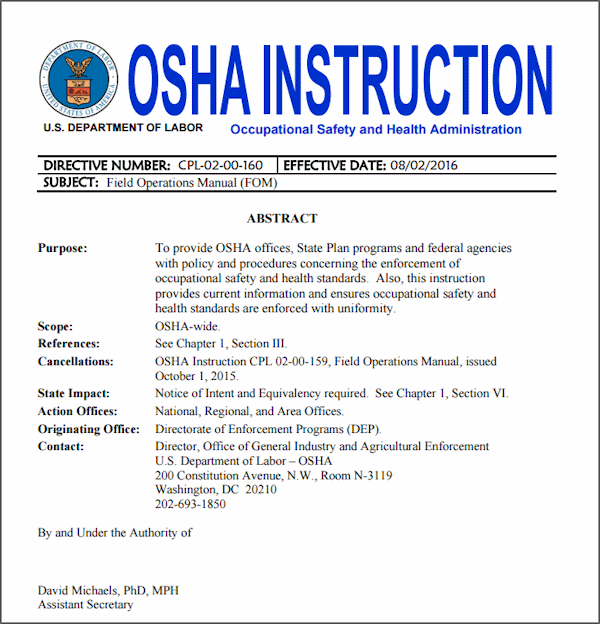OSHA Inspections
The OSH Act authorizes OSHA compliance safety and health officers (CSHOs) to conduct non-notice workplace inspections at reasonable times. See detailed requirements in the Field Operations Manual (click on image). OSHA conducts inspections without advance notice, except in rare circumstances (e.g. Imminent Danger) In fact, anyone who tells an employer about an OSHA inspection in advance can receive fines and a jail term.
Inspection Priorities
OSHA cannot inspect all 7 million workplaces it covers each year so it focuses inspection resources on the most hazardous workplaces in the following order of priority:
- Imminent danger situations: Hazards that could cause death or serious physical harm receive top priority. Compliance officers will ask employers to correct these hazards immediately or remove endangered employees.
- Fatalities or hospitalizations: Employers must report work-related fatalities within 8 hours and work-related inpatient hospitalizations, amputations, or losses of an eye within 24 hours. CSHOs gather evidence and interview the employer, workers, and others to determine the causes of the event and whether violations occurred.
- Worker Complaints: A worker or worker representative can file a complaint about a safety or health hazard in the workplace. Allegations of hazards or violations also receive a high priority. Employees may request anonymity when they file complaints.
- Referrals: Hazards are referred from other federal, state or local agencies, individuals, organizations or the media. Referrals usually are from a government agency, such as NIOSH or a local health department.
- Targeted inspections: These inspections are aimed at specific high-hazard industries or individual workplaces that have experienced high rates of injuries and illnesses.
- Follow-up inspections: The primary purpose of a follow-up inspection is to determine if the previously cited violations have been corrected.
Knowledge Check Choose the best answer for the question.
4-4. Which of the following types of OSHA inspections has the highest priority?
You forgot to answer the question!

